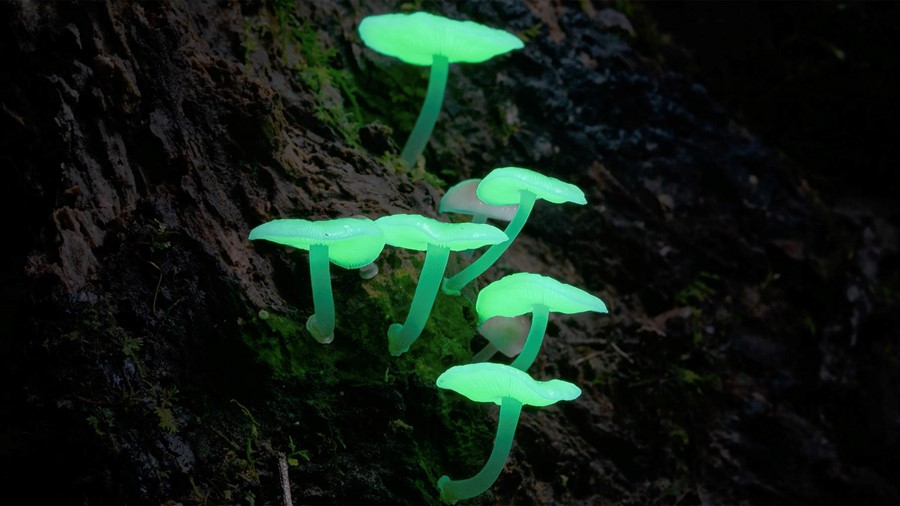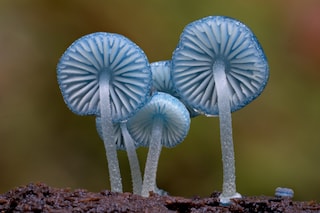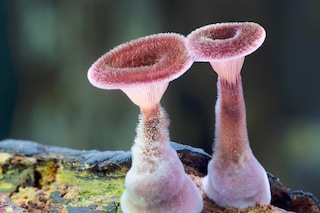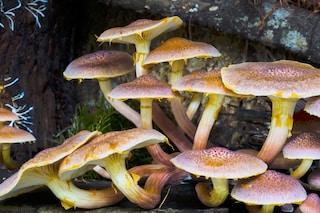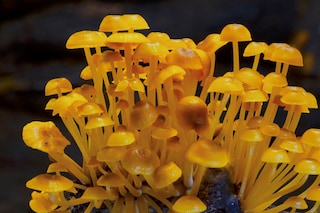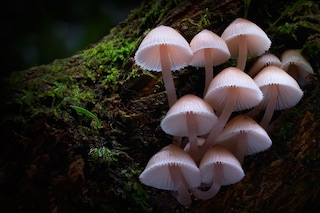Presented by Merlin Sheldrake, Fungi: Web of Life features jaw-dropping time-lapse footage in which fungi germinate like majestic, otherworldly creatures
The British biologist and writer Merlin Sheldrake is to mushrooms what Björk is to music. The bestselling author of 2020’s Entangled Life: How Fungi Make Our Worlds, Change Our Minds, and Shape Our Futures, Sheldrake is also the presenter of Fungi: Web of Life, a hypnagogic, Björk-narrated, 3D documentary that’s screening at BFI IMAX. And, believe me, you haven’t really seen Tasmania’s ancient Tarkine Forest until it’s been projected at 60ft in front of your eyes with laser technology – unless you’ve actually been to the Tarkine Forest, in which case there are worse memories to revisit.
In person, Sheldrake, who’s been described by the Guardian as “Timothée Chalamet playing a Cambridge academic”, is warm and inviting in his passion for fungi – not unlike Björk in the documentary. “Fungi are a kingdom of life, which is as broad a category as animals or plants,” he tells me in early February, in London, at his parents’ house. “But fungi are a kingdom of life that’s not had a kingdom’s worth of attention. We neglect fungi. That’s a problem. What we neglect, we tend to destroy or ignore. We can’t afford to do either with fungi.” He adds, “And it’s fun to know about fungi – it isn’t a chore! An account of a world that doesn’t include fungi is an account of a world that doesn’t exist.”
As Björk declares in Fungi: Web of Life: “The living world is connected by a hidden kingdom of life we’re just beginning to understand.” Simply put, without fungi, there would be no life on Earth. Humans rely on fungi for food and medicines. Plants and trees depend on fungi. In the soil, mycorrhizal fungal networks supply nutrients to plants like underground cables, to the extent that if all the fungal mycelium cells were stretched out, they would comprise more than 450 quadrillion km in length. Confused? Helpfully, the “wood wide web” is illuminated on the IMAX screen like a mash-up of Planet Earth and The Matrix. Elsewhere, in jaw-dropping time-lapse footage, fungi germinate like majestic, otherworldly creatures that, somehow, are very real and all around us.
With 95 per cent of fungi still undefined, their potential is insurmountable. Right now, advancements are being made with fungi in terms of battling cancer and epilepsy; in China, scientists are even experimenting with a type of fungi that breaks down plastics. “They’re chemical wizards,” Sheldrake says. “They make soil. They’re driving the nutrient cycles the planet depends on.” Plus, let’s not forget, mushrooms can enhance a nature doc in exactly the way you can imagine. Although Sheldrake declines to officially recommend mushrooms instead of popcorn, he beams when I reveal that there’s a five-star Letterboxd review in which a cinemagoer microdosed in the theatre.
“Lots of people are aware of psychedelic compounds,” says Sheldrake. “They can change the way we think, feel, and imagine. They can also help us deal with really problematic psychiatric disorders like depression and anxiety. They can help people deal with the existential dread that follows a terminal diagnosis. They can help people with addictions. There’s a lot of new research right now. It’s a really exciting time.”
On a big screen, fungi are remarkably cinematic. In their sprouting, tendrilled glory, the organisms are simultaneously majestic and distressing; with 3D, they’re capable of provoking feelings of awe and wonder, as well as triggering trypophobia. Due to some negative connotations, fungi might provoke sharp reactions from viewers who have been brought up to be cautious around mushrooms – or perhaps those who saw Phantom Thread or the cordyceps brain infection in The Last of Us. Sheldrake, however, wishes to address these misconceptions.
“People associate fungi with death, decay, and disease,” he says. “Indeed, they are a part of death, decay, and disease. But they’re responsible for so much more than that. They’re a living seam by which much of life is woven into. They hold ecosystems together. They put the ‘system’ into ‘ecosystem’.” While fungal diseases can cause problems with crops and humans, Sheldrake insists that they entail only a tiny percentage of the fungal kingdom. “A lot of fear about fungi is unjustified.”
It helps, then, that Fungi: Web of Life is narrated by Björk, a singer whose obsession with fungi mushroomed into Fossora, a 2022 album that includes tracks like “Fungal City” (“Fungal city subterranean/Curve the forest floor”) and “Fossora” (“Her nerves spread like wings/At mycelium speed/Into the atmosphere/There’s spores everywhere”). As an avowed fan of Entangled Life, Björk was put in contact with Sheldrake. “It was recently I heard that she’s been getting into fungi,” he says. “So we had conversations about that.”
In her hushed whisper, Björk offers an insightful, soothing narration that seeks to simplify the science, rather than overwhelm viewers who may already be struggling with an onslaught of exquisite, fungal imagery. In short, it’s Björk doing David Attenborough, except with her own, inimitable intonation. “Björk’s fascinated about our relationship with the living world, the biosphere, and life in all of its beauty and strangeness,” says Sheldrake. “She said it’s been a long-term dream of hers to narrate a natural history documentary. It’s exciting that she’s a part of ours.”
As Björk was a late addition to the project, what was her key input? “Mainly her voice,” says Sheldrake. “It’s such an important role to welcome people into the story. It’s like hospitality: you’ve got to make sure that people feel welcome; that they trust you. You’re going to show them around a strange world, and it’s hard to get that balance right. She brings the magic and curiosity. You feel safe in her voice.”
In terms of fungi and art, Iris van Herpen and Stella McCartney are among the big names to have contacted Sheldrake for mushroom-related collaborations. Sheldrake, himself, is a musician whose YouTube page showcases him playing piano alongside electric signals transmitted from fungi via electrodes. “I find some types of music helpful to understand fungal life, especially musical polyphony, when there’s more than one voice,” he says. “Fungi live in the soil where it’s a place full of vibrations. There’s preliminary suggestions that they can respond to vibrations and sounds.”
It’s apparent from startled responses to Fungi: Web of Life – and, indeed, Entangled Life – that fungi are neglected in educational programmes and high-school curricula. One hope with the film is that viewers, especially younger ones, will learn of the imperative role of fungi in battling climate change, and the ensuing perils of deforestation. “We’re destroying the living world at such an alarming rate,” Sheldrake laments. “We want to motivative people to feel the urgency of the destruction, but to also feel the possibility to do something about it.”
Above all, fungi are key players in the biosphere. “Fungi draw down carbon into the soil, and are key allies for us as we try to battle climate change,” Sheldrake explains. “When we destroy fungal habitats and communities, we jeopardise our efforts to eliminate global heating and biodiversity loss. That’s the key message: fungi are key partners for us as we look towards the future of life on a damaged planet.”
Fungi: Web of Life in IMAX with Laser 3D is screening at BFI IMAX, London SE1
